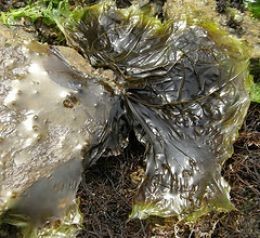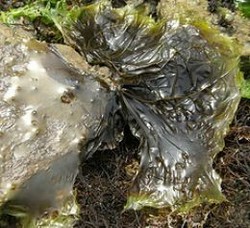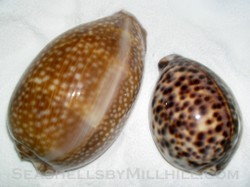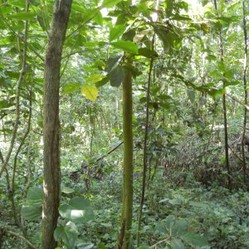
Porphyra
by NAIZA
Porphyra is considered to be the most edible among sea weeds, it is often used in certain diet and Oriental cooking.
Porphyra belongs to the group of red algae and grows between sea shore and cold waters of temperature oceans. The cultivation of Porphyra somehow began 17th century in East Asian countries like Japan, Korea and China and since then it became the most widely industries using shallow water areas in these countries.
In 1949, Kathleen Drew Baker, a British phycologist who discovered the life cycle of the Porphyra (alga Conchocelis rose) and notice how its life cycle is similar to the Japanese sea weed or nori. This was a great discovery for the farming industry that prevented the artificial production of seeds.
- Common Name:
Nori/Laver - Family: Bangiaceae
- Phylum: Rhodophyta
- Genus: Porphyra
Physical Characteristics
Porphyras has blade-like branches forming from circular to linear outline and a few centimeters to over a meter in length. Its color varies from rose-pink to mottled reds, yellows, browns and greens that submerge entirely in water.
Often, porphyras appears on rocky shorelines throughout the world that include a few species in the tropics. It has the greatest diversity basically found in a colder temperature and boreal regions. Some species appear as winter or summer annuals. It can be very versatile and can bear extreme weather condition like the highest, driest intertidal zones. They appear in nature as a free living organism and its filaments bore into calcium carbonate such as oyster shells.
It also has a very complex life cycle due to its diploid microscopic stage called conchocelis which consists of filamentous branches. Its filaments form a swollen branches called conchosporangia as an individual cells without walls.
 |
Books about Porphyra
 | Porphyra: Harvesting Gold from the Sea The intent of this book is to offer a primer to any individual, family, village cooperative, NGO, state, federal funding agency, or corporation that wishes to introduce ... I K International Publishing House |
 | Red Algae in the Genomic Age (Cellular Origin, Life in Extreme Habitats and Astrobiology) This volume covers the modern biology and the speciation of the red algae (Rhodophyta) from unicellular Cyanidia up to macrocellular sea weeds. A team of peer reviewers has ... Springer |
 | An account of the species of Porphyra found on the Pacific coast of North America University of Michigan Library Only $10.99 |
Habitat
According to FAO Fisheries and Aquaculture that in China, porphyra haitanensis, a certain kind of specie, can be found in southern areas while P. yezoensis is found in the north. Its life cycle is commonly called nori or laver and comprise the thalli of the species which can survive and grow in autumn or earlier winter rocky coasts. Its seeds are called conchospores which released from the filamentous conchoelis stage.
Uses
As being said as the most widely used sea weed in the world for being rich in protein and free amino acids. It is also cut into small pieces and used in biscuits, dried for soups and candies. It become the favorite food among Asia particularly in Japan because it use in making sushi that adds up a very tasty taste into the dish.
In Japan, porphyra is known as laver, amanori or nori as an edible sea weed use to wrap the rice and the fish for sushi as well 'zakai, gim' in Korea for Korean food gimbap and 'sloke, karengo or slukos' in China.
Porphyra Resources
FAO Fisheries & Aquaculture Porphyra spp
This file contains a global overview of the aquaculture species Porphyra spp.
You might also like
Collecting Seashells: Types of ShellsA look at some seashells you may see on Florida beaches with photos of my own...
Benefits of Forests for HumansBenefits of rainforests to humans, moderation of climate, temperature, rainfa...



 Making Kimchi Pancakes -on 10/30/2012
Making Kimchi Pancakes -on 10/30/2012
 Leonardo da Vincion 06/01/2011
Leonardo da Vincion 06/01/2011
 Confuciuson 05/31/2011
Confuciuson 05/31/2011
 The Philippine Eagleon 05/31/2011
The Philippine Eagleon 05/31/2011



Did you learn something new today?
I've tried it in sushi wrappings, and it's delicious!
I did learn something new today, thanks. My daughter eats dried seaweed almost everyday. She loves adding it to rice rolls and just plane packed in her lunch. I had no idea sea weed was so important to our health as amino acids are paramount to maintain and stimulate HGH. Great article. :)K
I find seaweed really interesting to learn about, though I haven't yet developed a taste for it. It is very nutritious, though.